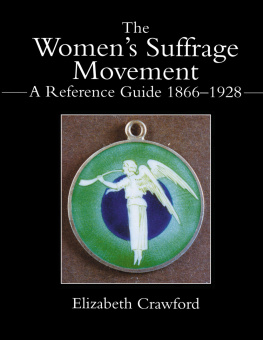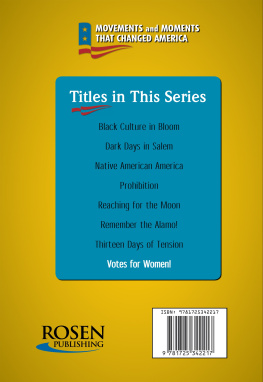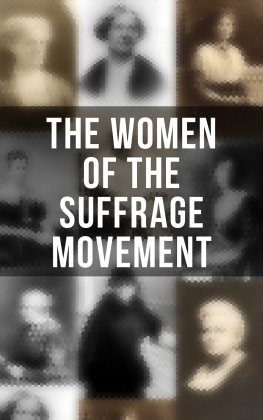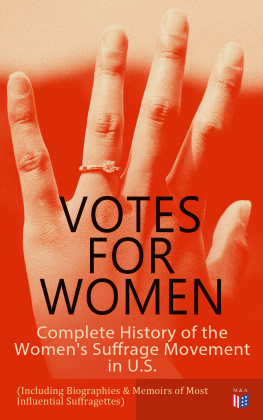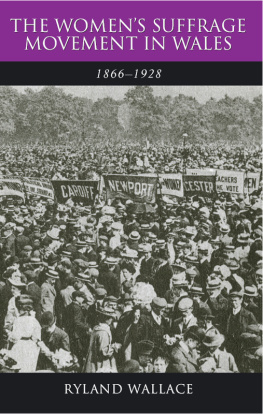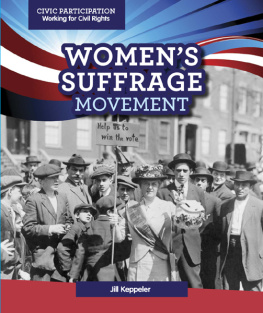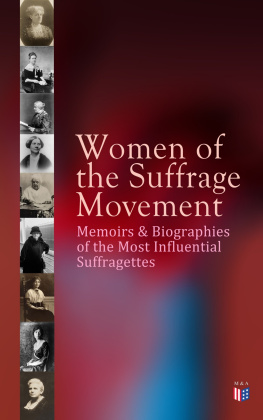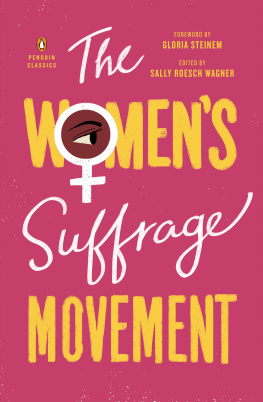Elizabeth Crawford - The Womens Suffrage Movement: A Reference Guide 1866-1928
Here you can read online Elizabeth Crawford - The Womens Suffrage Movement: A Reference Guide 1866-1928 full text of the book (entire story) in english for free. Download pdf and epub, get meaning, cover and reviews about this ebook. year: 1998, publisher: Taylor and Francis, genre: Detective and thriller. Description of the work, (preface) as well as reviews are available. Best literature library LitArk.com created for fans of good reading and offers a wide selection of genres:
Romance novel
Science fiction
Adventure
Detective
Science
History
Home and family
Prose
Art
Politics
Computer
Non-fiction
Religion
Business
Children
Humor
Choose a favorite category and find really read worthwhile books. Enjoy immersion in the world of imagination, feel the emotions of the characters or learn something new for yourself, make an fascinating discovery.
- Book:The Womens Suffrage Movement: A Reference Guide 1866-1928
- Author:
- Publisher:Taylor and Francis
- Genre:
- Year:1998
- Rating:5 / 5
- Favourites:Add to favourites
- Your mark:
- 100
- 1
- 2
- 3
- 4
- 5
The Womens Suffrage Movement: A Reference Guide 1866-1928: summary, description and annotation
We offer to read an annotation, description, summary or preface (depends on what the author of the book "The Womens Suffrage Movement: A Reference Guide 1866-1928" wrote himself). If you haven't found the necessary information about the book — write in the comments, we will try to find it.
The Womens Suffrage Movement: A Reference Guide 1866-1928 — read online for free the complete book (whole text) full work
Below is the text of the book, divided by pages. System saving the place of the last page read, allows you to conveniently read the book "The Womens Suffrage Movement: A Reference Guide 1866-1928" online for free, without having to search again every time where you left off. Put a bookmark, and you can go to the page where you finished reading at any time.
Font size:
Interval:
Bookmark:

The Women's Suffrage Movement
General Editor
June Purvis
Professor of Women's and Gender History, University of Portsmouth
Lynn Abrams and Elizabeth Harvey (editors)
Gender relations in German history: power, agency and experience from the sixteenth to the twentieth century
Margaret L. Arnot and Cornelie Usborne (editors)
Gender and Crime in Modern Europe
Elizabeth Crawford
The Women's Suffrage movement: a reference guide 1866-1928
Shani D'Cruze
Crimes of outrage: sex, violence and working women in Victorian England
Carol Dyhouse
No distinction of sex? Women in British universities, 1870-1939
Elizabeth Edwards
Women in teacher training colleges: a culture of femininity, 1900-1960
Bridget Hill
Women , work and sexual politics in eighteenth-century England
Louise A. Jackson
Child Sexual Abuse and the Law in Victorian England
Linda Mahood
Policing gender, class and family: Britain, 1850-1940
Jane McDermid and Anna Hillyar (editors)
Midwives of the revolution: female Bolsheviks and women workers in 1917
June Purvis (editor)
Women's history: Britain, 1850-1940
June Purvis and Sandra Holton
Votes for Women
Gillian Scott
Feminism and the politics of working women: the Women's Co-operative Guild, 1880s to the Second World War
Wendy Webster
Imagining home: gender, 'race' and national identity, 1945-64
Barbara Winslow
Sylvia Pankhurst: sexual politics and political activism
A Reference Guide 1866-1928
Elizabeth Crawford
S then stands for Suffrage
The question of the hour;
Its suffering at present
But by and by its power
Mary Lowndes, A.B.C. of Politics for Women Politicians

First published 1999 in the UK and the USA
by UCL Press
11 New Fetter Lane
London EC4P 4EE
The name of University College London (UCL) is a registered trade mark used by UCL Press with the consent of the owner.
UCL Press is an imprint of the Taylor & Francis Group
Elizabeth Crawford 1999
Typeset in Hong Kong by Graphicraft Ltd
Printed and bound in Great Britain by T.J. International, Padstow, Cornwall
All rights reserved. No part of this book may be reprinted or reproduced or utilised in any form or by any electronic, mechanical, or other means, now known or hereafter invented, including photocopying and recording, or in any information storage or retrieval system, without permission in writing from the publishers.
British Library Cataloguing in Publication Data
A catalogue record for this is available from the British Library.
Library of Congress Cataloging in Publication Data
A catalogue record for this book has been requested
ISBN: 1-84142-031-X
The women's suffrage campaign was a single-issue political campaign. Its first petition to parliament, presented by John Stuart Mill on 7 June 1866, was only one, passing virtually unnoticed, amongst that day's muster. Throughout the course of the next 62 years, until women achieved full enfranchisement in 1928, the women's suffrage campaign competed for attention in the lives of successive parliaments and, indeed, in the lives of the campaigners themselves. Using the Personal Rights Journal, the advocate of radical causes, as a lens through which to view the world of political lobbying in the 1880s, it is clear that, 20 years after it was launched, the aim and activity of the women's suffrage campaign was not expected to be of any greater interest, nor was it considered of intrinsically greater merit, to political activists of the day than any of the other issues of concern, such as land reform, Ireland, anti-vaccination (which if anything had greater exposure), compulsory education and early closing. Doubtless reference works similar to this one could be compiled for any of these issues and, indeed, would contain many of the same names. It is to us, looking back over the past 150 years, that the campaign for women's enfranchisement has a particular resonance. By tracing, from its faltering beginnings, the process in its various strands, constitutional and militant, we map women's journey not only into citizenship but also into a society which that citizenship has progressively feminized. The journey's winding path has been obscured by the knowledge that the goal was, eventually, attained. The byways and wayside dallyings of the campaign are of intrinsic interest as stages in its development, fuelling spurts of growth or new lines of attack. The women making this journey had the company of friends and relations to sustain them, and to guide them the compass of principle - that women were as equal in value to society as were men. It soon became clear, as parliament ignored the argument, that principle was not enough. Although other feminist campaigns, such as that to give married women control over their own property, that to repeal the Contagious Diseases Acts, that to give widows joint guardianship of their children, and that to give suitably qualified women local government enfranchisement, were successfully manoeuvred through parliament, the machinery of government was engineered to exclude women from its workings and again and again was activated to do so. When it very quickly became clear that the argument would not be won on principle, it moved to one of mechanics. It was the use to which a vote might be put that became the rationale given to answer those defending the status quo - that the interests of women would never be protected until they were in charge of their own destiny. It is clear, however, when reading the biographies of the campaigners, how strong a motivation was the feeling that the vote was a symbolic proof of self-worth and, conversely, that without the talisman of full citizenship, women were unprotected from shame in all its social and economic manifestations. The campaign reveals in so many ways the tension between the expectations of individual women and the position to which evolving society had assigned them. It was no coincidence that as the industrial, educational and social status of women "improved" (that is, became closer to that enjoyed by men) so the struggle for the vote became more determined. A study of the women's suffrage campaign highlights the tension between the "masculinity" of the political goal and the efforts to achieve it, both the "feminine" (spectacle and fund-raising, which employed a wide range of womanly skills), and the "masculine" (from speaking from platforms in public in the nineteenth century to terrorism in the twentieth).
Parliament was a machine that had evolved to run a patriarchal society. Women's interests were deemed to be subsumed in those of men. There is benefit to be gained in studying how women, peculiarly at a disadvantage as a parliamentary pressure group, employed a variety of strategies in order to influence the body from which they were barred. The image conjured up is of watching a game of chess in which one participant stands at a considerable distance from the board and, with concentration and dexterity that improves with practice, operates her pieces by nudging them into position with a length of shaky cane. The other player has little need to pay much attention to the board, other than to slam down a winning piece when the occasion arises. Successive governments had no difficulty in using parliamentary procedure to obstruct the introduction of any measure of full enfranchisement. Modern biographies of Gladstone, Asquith and Lloyd George, by omission, highlight how little, despite women's best efforts, the campaign impinged on the workings of government. Indeed, the goal was only achieved in 1918 when, as Martin Pugh has pointed out in Electoral Reform in War and Peace (1978), "it mattered very much less who had a vote than it had in 1832 because it was becoming less important to sit in Parliament whose Members were increasingly spectators in the drama of politics".
Font size:
Interval:
Bookmark:
Similar books «The Womens Suffrage Movement: A Reference Guide 1866-1928»
Look at similar books to The Womens Suffrage Movement: A Reference Guide 1866-1928. We have selected literature similar in name and meaning in the hope of providing readers with more options to find new, interesting, not yet read works.
Discussion, reviews of the book The Womens Suffrage Movement: A Reference Guide 1866-1928 and just readers' own opinions. Leave your comments, write what you think about the work, its meaning or the main characters. Specify what exactly you liked and what you didn't like, and why you think so.

